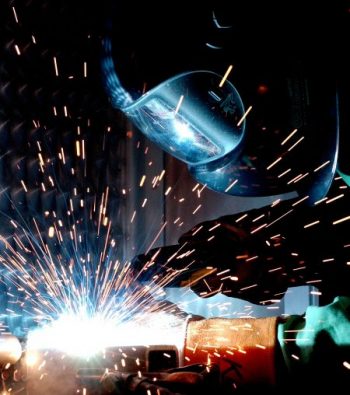A welding helmet, commonly referred to as a “hood,” is one of the most important pieces of personal protective equipment that a welder must have. An adequate helmet protects the eyes and skin not only from severe sparks, but also from potentially vision-damaging ultraviolet and infrared rays emitted by the arc.
As one of the most visible pieces of safety attire, a welding helmet also gives wearers an opportunity to add a bit of personal flair to their welding gear. With this is mind, today’s welding helmets are available in a wide range of colors and graphics. These visual features command attention, but a helmet’s protective features – combined with comfort considerations – are what welders should consider when selecting the right helmet for their needs. A welding helmet should be lightweight and well-balanced to ensure that it can worn comfortably for a full day’s work, providing flexible adjustments while protecting their eyes and face from spatter and sparks and harmful light rays.
Today’s helmets considerably are more functional than those of even 10 or 15 years ago. They are designed to accommodate a welder’s specific needs on any job. All, including the most inexpensive, must meet strict safety standards across the globe. In the United States, that standard is ANSI Z87.1 and in Canada it is CAN/CSA Z94.3. These standards address such concerns as light leakage and flame and impact resistance.
Passive Welding Helmets
Some welders, particularly many professional pipe welders, still opt to wear conventional welding helmets with a traditional glass lens and fixed shade, which remains darkened at all times. While these helmets do provide rugged and inexpensive safety protection, they also have a few disadvantages.
Welding helmets featuring a fixed shade can be more difficult to use because a welder has to lift the helmet every time he or she wants to examine the weldment and joint, set a position and prepare for welding and then flip the helmet down again when it’s time to strike the arc. This repetitive process can cause neck strain after a full day’s work and reduces the operators’ productivity. Additionally, in tight or restricted spaces, it can be difficult to move the helmet up or down.
For less-experienced welders, it can be difficult to keep the MIG gun, TIG torch or stick electrode in the correct position to begin welding in the joint after the helmet is lowered into place. Poor arc starts can result in weld defects, something any welder obviously wants to avoid.
Auto-Darkening Protection
One option available to welders are the more advanced auto-darkening helmets, which automatically adjust the shade from an inactive state (light) to an active state (dark) when an arc is initiated. These helmets protect from harmful light emissions at all times and darken to the pre-selected shade in milliseconds, thanks to quick-changing LCD (liquid crystal display) technology in the auto-darkening cartridges.
With auto-darkening helmets, welders can see clearly while the helmet is in the down position, allowing for quick material set-up and positioning with the hood in place to begin welding. These helmets increase welder productivity as they eliminate unnecessary stop-and-start times and the need for welders to readjust the helmet and set up positioning.
Selection Considerations
So what are the most important factors to consider when selecting an auto-darkening helmet? Quality? Control? Safety? Style? There are a number of general selection considerations that will help welders choose a helmet that best meets their needs, as well as finding one that comfortably can be worn all day long.
When assessing various auto-darkening helmets, look for models that have a full-coverage shell that was designed to reflect spatter and resist impact forces. The helmet also should comply with ANSI Z87.1 and CSA Z94.3 standards. This ensures that it was designed with North American safety standards in mind. Another safety feature to look for is a “test” mode that is integrated into the auto darkening lens. This allows the operator to check if the helmet is working correctly before initiating an arc.
The helmet’s viewing size also is a major factor to consider. While it is based on preference, a large viewing area increases the operators’ peripheral vision and can be very helpful when working on large weld assemblies.
A new specification to review is the color spectrum of the auto-darkening lens. In the past, auto-darkening helmets have had a lime green color spectrum. Recently, a few manufacturers have developed technology which alters the lenses color spectrum to give the operators a more natural view. This feature can improve the welders’ ability to control the weld puddle and reduce eye fatigue.
Another important specification to review is the helmets’ variable shade range. Entry-level, auto-darkening helmets normally allow the user to toggle between shades 9 through 13 while premium helmets offer a wider 5 through 13 range. This scale allows welders to optimize the shade for greater comfort on any given application. Anyone who moves between applications; requires changes in welding machine voltage; amperage or wire feed speed settings or changes between welding processes can benefit from this flexibility. For example, welding on thick materials at high amperages generally requires higher shade levels. Low-amperage MIG welding or plasma cutting is best performed with low-shade levels to assure adequate visibility of the arc.
Delay controls can be used to lengthen or shorten the amount of time it takes for the helmet to return to the light state following the completion of a weld. This can be helpful when tack welding, when the weld duration is short and the operator plans to move quickly. On the other hand, performing lengthy welds on thick materials may require that the delay be set for longer periods of time so that the operator does not have to view the larger, hotter weld nugget at the end of the weld until it has cooled for a second or two. Generally, delay can be set for 0.1 second up to 1.0 second.Some helmet models also allow the user to control delay and sensitivity. Modifying the helmet’s arc sensitivity helps to assure it will darken as the user desires. For example, if there are other welders operating very close by, the helmet’s arc sensor sensitivity can be reduced to help prevent triggering or darkening when those nearby welders strike their own arc.
Count the number of arc sensors on the helmet. Some auto-darkening helmets have one or two arc sensors, while others can have up to four arc sensors. With more arc sensors, there is less chance that the helmet will fail to darken as necessary.
Auto-darkening helmets feature either external or internal controls for functions like shade or grind control. Both have advantages and disadvantages, depending on your requirements. The external controls add convenience, allowing some adjustments to be made while the helmet is on the head. On the other hand, external controls include additional wiring and can be exposed to additional impacts or damage as they are positioned on the outside of the helmet. Internal controls positioned on the lens cartridge are more protected and do not require external wiring. However, almost every adjustment will require removing the helmet to change settings.

Auto-darkening helmets are powered in different ways. Some feature replaceable lithium batteries. Others use a combination of solar cells with user-replaceable lithium batteries, while other models feature solar power with a battery assist. Any of these methods work well. The choice comes down to personal preference.
Helmets with user-replaceable batteries offer the potential for longer total service life of the helmet as those with non-user replaceable batteries generally are anticipated to have a service life of five to seven years. On the other hand, users handling models with replaceable batteries are advised to have replacement batteries on hand. If the helmet has an on/off switch, the user must remember to turn the helmet off after use.
Read more at EHSToday.com





